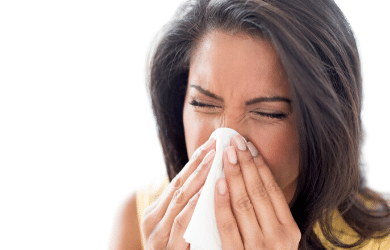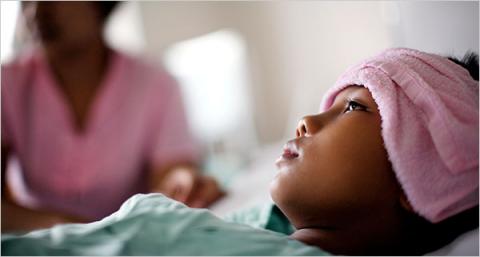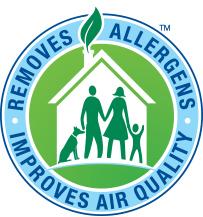Cold, Flu, Allergies: Can You Tell the Difference?
October 20, 2015
 Fall is often thought of as the gateway to cold and flu season. Many people are already starting to safeguard themselves and their families against the germs that frequently accompany the season of sniffles and flu shots.
Fall is often thought of as the gateway to cold and flu season. Many people are already starting to safeguard themselves and their families against the germs that frequently accompany the season of sniffles and flu shots.
But what about allergies? Cooler weather means less pollen and, therefore, fewer allergies, right? Not necessarily. In fact, cold and flu season may make fall allergies trickier to spot and properly treat.
How to Identify the Source
According to the Asthma and Allergy Foundation of America, approximately 35 million people in the US suffer from pollen allergies, or hay fever. Unfortunately, fall allergies and the flu and cold share some of the same symptoms: sneezing, a runny or stuffy nose; coughing; itchy nose and throat; and dark circles under the eyes.
So, how can you tell the difference?
- Time – Flu and cold symptoms typically appear and clear over the course of a few days; but allergic reactions occur almost immediately and can last a long time, even year-round if you’re continuously exposed to the allergen.
- Treatment – Colds and the flu have to run their course, but allergy symptoms like postnasal drip and swollen, watery and/or itchy eyes can be improved with proper treatment.
- Temperature – If you have a fever, you more than likely have the flu or a cold.
 Knowing how to identify the source of your symptoms makes treatment much easier. However, as with many things in life, the best defense is a good offense. Just like we take measures to limit the threat of colds and the flu, we can also do a few easy things to help safeguard against hay fever. The first step is to understand common fall allergens.
Knowing how to identify the source of your symptoms makes treatment much easier. However, as with many things in life, the best defense is a good offense. Just like we take measures to limit the threat of colds and the flu, we can also do a few easy things to help safeguard against hay fever. The first step is to understand common fall allergens.
Safeguard against Fall Allergies
- Outdoor Allergens — Ragweed is very prevalent in the fall and can produce (and send airborne) up to one billion pollen grains per plant, making it responsible for 75% of reactions in people with hay fever allergies. Another big outdoor allergen this time of year is mold, which can lurk in the stalks of your favorite corn maze or hay bale ride, not to mention all those beautiful mounds of multi-colored leaves.
- Indoor Allergens — If you’re thinking the best way to avoid fall allergies is to stay indoors, think again. A recent independent study found that indoor air can be 10 times more polluted than outdoor air. Part of the reason for this is that, in addition to existing indoor allergens, outdoor allergens sneak indoors on our clothes, our hair, our pets and more.
- Airborne Allergens — Opening windows and doors seems like a good idea in milder temperatures, but that fresh air can also carry airborne allergens, such as ragweed, right into your home, especially on days with high pollen counts. If you still want to air out your home, consider consulting a website or app from a reputable source, such as The Weather Channel, that offers an allergy tracking feature to monitor allergen levels in your area and wait for low level days before throwing your doors and windows wide open.
Reduce, Remove, Relieve
Again, like colds and the flu, you can limit exposure to allergens, but you can’t block them out completely. The second step is to reduce and remove existing allergens for maximum relief. High-efficiency filters and regular cleaning can help reduce and remove common non-living allergens and relieve fall allergy symptoms.
- Reduce — Installing a high quality furnace filter with a minimum filtration rating of MERV 8 to attract and capture airborne allergens like pollen, dust and dander, and vacuuming your carpets and rugs once or twice a week with a three-stage HEPA filter vacuum will help reduce allergens in your home.

- Remove — Start the season right with a deep cleaning by a local Chem-Dry carpet cleaner. In a study conducted by a leading independent lab, our proprietary Hot Carbonating Extraction (HCE) process was found to remove, on average, 98% of common non-living allergens* from carpets and upholstery. Not only that, our low-moisture HCE process uses about 80% less water than typical steam cleaning, so your carpets dry in hours instead of days and you don’t have the risk of mold and mildew growth that comes from using an excessive amount of water. A professional cleaning from Chem-Dry is safer for your home and healthier for you and your family.
- Relieve — Even after taking proactive measures, some indoor and outdoor allergens are going to find their way into our lives and our homes. But that doesn’t mean we have to live with them. Whether you suffer from allergies and/or asthma or you just want to provide the healthiest home for your family, a Chem-Dry carpet cleaning can help you remove the non-living allergens hiding in your home and improve your indoor air quality.
To learn more about creating a healthy home, schedule an appointment or request a free quote, find a Chem-Dry carpet cleaner in your area.
*Based on results from a study conducted by an independent laboratory using the Chem-Dry Hot Carbonating Extraction process. Allergens tested were dog and cat dander and dust mite matter. Figures are an average across multiple homes.